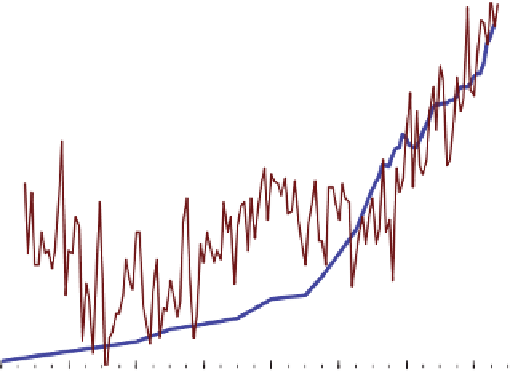Environmental Engineering Reference
In-Depth Information
30000
0.9
Mt
°C
25000
0.7
20000
0.5
temperature
15000
0.3
10000
0.1
5000
-0.1
CO
2
emissions
0
-0.3
1860
1880
1900
1920
1940
1960
1980
2000
Figure 2.8
Progression of energy-related CO
2
emissions and global changes in
temperatures since 1860.
are so large that they can easily be detected from space. If this does not change
during the next few years, almost all the woodland in the world will be gone in
about 100 years. During this time large quantities of carbon dioxide will be released,
causing 10% of the greenhouse effect. However, the remaining CO
2
originates
largely from the burning of fossil energy sources.
2.2.3 Other Culprits
Fossil energy use is not the only culprit. Agriculture, the clearing of rainforests and
industry are also responsible for the additional greenhouse effect caused by people
(see Figure 2.6).
Aside from carbon dioxide, there are other substances released through the actions
of people that cause the greenhouse effect. Methane, hydrofl uorocarbons (HFCs),
ozone and nitrous oxide are some of the key ones. Although the concentration of
these elements in the atmosphere is considerably lower than that of carbon dioxide,
they have a much higher specifi c greenhouse potential.
The greenhouse potential of methane is 23 times that of carbon dioxide. This means
that 1 kg of methane causes just as much damage as 23 kg of carbon dioxide.
Methane is the second most important greenhouse gas. Through the infl uence of
man the concentration of methane in the atmosphere has already more than doubled.
Methane is also emitted during the exploitation of fossil energies. It escapes
during natural gas extraction and coal mining, as well as from defective natural
gas lines. Refuse disposal sites are another source for the emission of methane
(Table 2.2 ).

































































